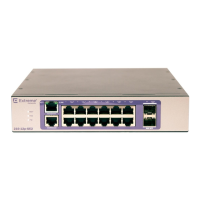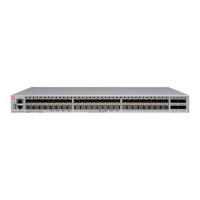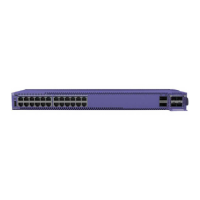For more information about specialized terms used for stacking, see Stacking Terms on page 53.
Stacking Terms
Table 7 describes common terms used when stacking 220 series switches. The terms are listed in the
recommended reading sequence.
Table 7: List of Stacking Terms
Term Description
Stackable switch or Unit A switch that is part of a stack or that can be added to a stack.
Stacking link A cable that connects a stacking port of one stackable switch to a stacking port of
another stackable switch, plus the stacking ports themselves.
Stack A set of up to four 220 series switches connected by stacking links through their 10
GbE SPF+ ports. One of the switches controls the operation of the stack and is
called the stack manager. All of the switches in the stack use stacking technology
to behave and work together as a unified system. Layer 2 and Layer 3 protocols
present the entire switch stack as a single entity to the network.
Stack topology A contiguously connected set of switches, or units, in a stack that are currently
communicating with one another. The switches are arranged in a ring, with the last
unit in the stack linking back to the first unit.
Role The function that each unit plays in the stack – either manager, standby, or stack
member.
Stack manager The unit that is elected as the primary node in the stack. You can manage the
entire stack through the stack manager. The stack manager runs all of the
configured control protocols, for example RIP (Routing Information Protocol) and
Spanning Tree.
Standby The unit that takes over the role of manager if the stack manager fails. When a
failure occurs, all units in the stack detect the failure and the standby automatically
takes over as manager. During the takeover, the stack continues to forward
network trac with minimal disruption.
Data ports The set of ports on a stackable switch that are available for connection to your
data networks. Such ports can be members of a user-configured VLAN or trunk
group. They can be used for Layer 2 and 3 forwarding of user data trac, for
mirroring, or other features you can configure. Data ports are dierent from
stacking ports.
Failover A process for changing a standby unit to the stack manager.
Failover occurs automatically, when the stack manager fails, or it can be initiated
manually (warm failover), using the initiate failover command. The
other stack members continue to operate without interruption.
Warm failover
A failover that is initiated manually, using the initiate failover
command.
Recommendations for Placing Switches for Stacked Operation
For best results in a stacked configuration, follow these recommendations for physically situating your
equipment:
Building Stacks
ExtremeSwitching 210 and 220 Series Switches: Hardware Installation Guide 53

